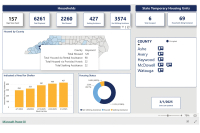Unexpectedly high bids could clog up Waynesville sewer project
 Waynesville’s new sewage treatment plant is supposed to be completed by Dec. 31, 2024. Haywood GIS photo
Waynesville’s new sewage treatment plant is supposed to be completed by Dec. 31, 2024. Haywood GIS photo
There’s been no more pressing issue in Waynesville during the past two administrations than the replacement of the town’s aging sewer plant, but after skillfully guiding the project through multiple obstacles over the past five years, aldermen must now find a way to clean up another big mess — project bids almost 50 percent higher than expected.
“I think it’s just a timing issue with cost of goods and services that has pushed it over and I think we need to do a really good job of going through all the channels that we can to get a lower price or get some additional funds toward that project,” said Alderman Anthony Sutton.
It seemed as though the half-decade endeavor to replace the failing plant was finally entering the home stretch, until Waynesville Town Manager Rob Hites told the Board of Aldermen on Jan. 11 that the lowest bid came in at $28 million, far above the $19.4 million, 26-year, zero-interest loan the town had secured to pay for the project, which was slated for completion by Dec. 31, 2024.
That loan would be paid back by increasing rates to sewer customers, to the tune of around 50%. Small rate hikes started in 2018 and are about halfway to where they need to be, but the unexpectedly high bid would push sewer bills to an untenable level.
During that same Jan. 11 meeting, Hites said that average bills were projected to be around $46 a month once final rates are adopted, in line with state guidance that they should be less than $50.
However, if the high project bids are accepted without additional grant funding, those bills could skyrocket to $70 or $80, according to Hites. Given that Waynesville also serves the Junaluska Sanitary District as well as the Town of Clyde, those customers could see higher bills as well.
Related Items
“We’re probably getting the best price we’re gonna get for a couple years,” Hites said. “Without help from the state and our political people, I suspect our sewer bills are gonna skyrocket. Normally we would seek new bids, but the problem is that the ARP and ‘Build Back Better’ have provisions in them that if you’re going to use any federal money at all, you have to use U.S. steel,” Hites said.
From July of 2020 through July of 2021, the price of American-made steel has increased nearly 300%, mirroring other construction commodities.
“The price of a ductile iron pipe has gone up 330% in the last four or five months,” Hites said. “The cost of concrete and the cost of steel skyrocketed. We’re not the only city in our area that got stuck this way. Some of the other cities around us bid stuff out and are $3 million and $4 million higher than they planned.”
Indeed, estimates for a $20 million pool proposed for Jackson County recently came in $2 million over budget.
Making matters worse, the state received around half a billion dollars in funding for projects like Waynesville’s sewer plant, but upwards of 90% of that has been earmarked for distressed communities.
Waynesville is not a “distressed” community, despite fines being levied by the state for the plant’s poor operational history over the past few years.
“The state has a list of what they call distressed communities. This would be like Robbinsville, for instance. They had one textile mill, the textile mill closed, and they hadn’t done anything to their sewer plant and it’s basically falling apart. It sounds a lot like ours actually,” Hites said. “They’ve set aside all but $55 million for this list of distressed communities. So the rest of us only have $55 million to spread around.”
Hites objects to that methodology.
“If you’re going to take a small community that has a $20 sewer bill and give them a grant so they keep a $25 sewer bill but then those of us that have really negotiated just to get our bill under $50, we’re not qualified for the grants,” he said. “I don’t think there’s any fairness in that.”
Stuck between a rock and a hard place, the town may be able to borrow more low- or no-interest money from the state to bridge the gap, but it would eventually have to be paid back through the higher bills for customers.
“I don’t feel good about that at all,” he said. “Things weren’t done in the past that would have alleviated the necessity for this now. We’re too far in that we can’t just back out, because we have to have a working sewage treatment facility. We’ll do everything that we can to prevent additional fees.”
The town’s sewage treatment facility was completed in 1965 and saw updates in 1979, 1984, 1995 and 2001. It’s currently certified to handle 6 million gallons a day, but has seen up to 8 million gallons during occasional storm events.









